It would be
hard to explain and understand that how village which remained a centre of
attraction almost for about six centuries lost its glory and went into
oblivion. Bagali narrates its story in about 45 odd inscriptions spanning
across 6 centuries and 4 great dynasties though at present it has been reduced
to a small village.
The earliest
inscription found here is of the early 9th A.D. pertaing to the
times of Rashtrakutas. Later inscriptions are of Chalukyas of Kalyana, Hoysalas
and Vijayanagara rulers. Bagali is referred as Balgali during the medieval
period was an important Aghrahara right from the times of the Western Chalukyas
of Kalyana who were succeeded by the Hoysalas and Vijayanagara.
The
Kallesvara Temple was constructed during the region of the Western Chalukyan
King Ahavamala in 987A.D. and constructed by Duggimayya. As per the Inscription
the main deity is known as Kalideva. The east facing temple is constructed
close to the embankment of a huge tank of the village Balagi to its north.
Beautiful Sculpture depicting Hiranyakasupu being killed by Narasimha
Swamy
The shrine Surya facing the Shiva were built dedicated to sun god. The
face of Surya is most artistic and is commentary on the success of the skill of
the sculptor who carved it. The serene expression of the face is remarkable.
The total effect
is one of majesty, grace and dignity and expression his compassion towards the fellow
beings and hence is considered as the best in this type much of the drapery on
the bust of the image ornamentation comprising jewelry around his neck and
chest.
The temple on
plan consists of a Garbhagriha, an Antarala, A Mahamandapa with an entrance to
the south and east, A huge open Sabhamandapa, A shrine for Surya with an
astylar Mukhamandapa built slightly away from the main entrance, all of which
are in east west orientation, A shrine of Narasimha with a separate Antarala
and passage is added to the north of the Sabhamandapa of the main temple.
The
Sabhamandapa is well known for its fifty four ornate pillars supporting the
highly decorated ceiling of these twenty four pillars are located over the
Jagati provided with Kakshasana.
The temple is
also known for its intricately carved doorways with multiple door Jambs. The
estern end of the Sabhamandapa accommodates an ornate well executed couchant
Bull (Nandi).
There are
eight sub-shrines built around the main temple excellent sculptures of late
Chalukyan style are kept in the Mahamandapa of the temple and they includes
Shiva, Umamahshvara, Ganesh, Kartikeya, Surya, Anantashayana, Saraswathi and
Mahishamardini.
Erotic
sculptures are rarely seen in Kalyani Chalukyan temples, the Balligavi temple
being the excepton here erotic sculpture is limited to a narrow bans of friezes
that run around the exterior of the temple or on panels in the Sikhara.
There are some erotic sculptures which are a testament to the open
mindedness of our ancient people and give some insight to the sexual practices
a thousand years ago. The images found here depict weird practices, which
probably would remain an enigma to everyone. Many panels depict extra marital
sex and adultery.
Thus the
sculptors have successfully recorded intimate personal lives of the people of
that era for the benefit of posterity. Different panels could be very
profitably studied in order to trace initiation to logical conclusion of erotic
activities. There are several panels which indicate that very intimate moments
are prerequisite to kindle sexual desires.
Art historian
Adam Hardy classifies the architectural style of the temple as "Late
Rashtrakuta Vimana with erotic carvings, and a closed Mantapa, fronted by a
Later Chalukya non-mainstream open Mantapa, the building material for which is
soapstone".
The existing
tower over the shrine may be a later day re-construction. The temple, whose
premises have yielded 36 old Kannada inscriptions, there are as many as thirty
six inscriptions in the temple assignable to the 10th -11th
century A.D. which record donations to the Gods Kalideva and Narasimha.






















No comments:
Post a Comment